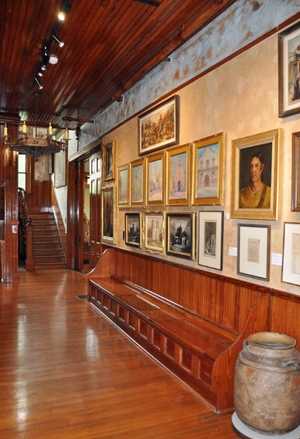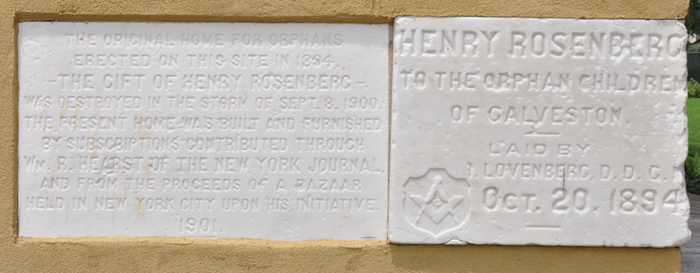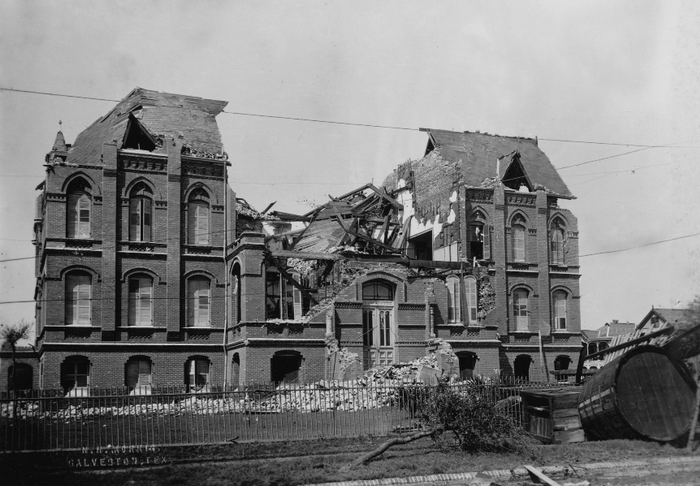Galveston Island is now home
to the beautiful new Bryan
Museum at 1315 21st Street,
but the walls of the museum building hold stories from a very different past.
For over 100 years, the halls echoed with the voices of orphaned children who
made their home in the grand building which is estimated to have housed nearly
6,000 over that century.
 The Beginning
The Beginning
Merchant George Dealey arrived in Galveston
from England
with his wife Mary Ann Nellins Dealey and their nine children in 1870. Highly
involved in community service, he regularly visited the city hospital to read
to patients and pass out religious literature.
During those visits he met a widow who worked there, Mrs. E. M. Arnold,
and shared his vision of creating a city orphanage with her. The only such
institution at the time was St. Mary’s, which only accepted children who were
Catholic.
She agreed to manage the orphanage as its directress, and he appointed
himself secretary-treasurer. Dealey used his own money to rent a house on
Broadway and 8th Street,
and in October of 1878 Mrs. Arnold set up housekeeping there with one orphan
whose family had died at sea and one child of her own.
When the landlord learned that the property was to be used as an
orphanage, he refused to rent to them the second month. Dealey rented a second
home owned by Mrs. John Hibbert on Market and 11th Street, naming it the
“Island City Orphans Home.” The new landlady, upon learning who was to be housed
on the property, immediately offered to lower the rent.
Donation boxes were set up around town, including at the post office,
the opera house and the Tremont Hotel, and merchants donated clothing, food,
and fuel.
 Within a year, twenty boys and girls occupied the home, and Dealey
realized larger accommodations were necessary. After meeting with community
leaders, Dealey stepped down from responsibility and a board of directors was
formed in 1879. The name was changed to the Island City Protestant-Israelitish
Orphans’ Home, reflecting the backgrounds of board members.
Within a year, twenty boys and girls occupied the home, and Dealey
realized larger accommodations were necessary. After meeting with community
leaders, Dealey stepped down from responsibility and a board of directors was
formed in 1879. The name was changed to the Island City Protestant-Israelitish
Orphans’ Home, reflecting the backgrounds of board members.
In May 1880, the name was simplified and returned to the original
“Island City Orphans Home.” The board of directors elected a permanent board of
thirteen trustees to handle business and legal matters, and chose twenty-eight
women to comprise a board of lady managers to manage the home’s domestic
affairs. They were in charge of day-today operations of the home and began
hosting an annual charity ball to benefit the orphanage. This ball became one
of the city’s most anticipated regular events, with the last one being held in
1981.
In 1881, donations totaling $3,000 were used to purchase a building at 21st Street
and Avenue M originally known as the “Colonel
Bolton Place.” Another $3,500 was invested to
update the home into a suitable facility for the large number of children.
 Two years later, Galveston philanthropist
Henry Rosenberg left $30,000 in his will to be used to build a new home for the
orphans, allowing the organization to hire Alfred Muller, who also designed the
Trube Castle, to design a new facility. The
cornerstone was laid in October 1894, containing a time capsule that included
information about Rosenberg.
Two years later, Galveston philanthropist
Henry Rosenberg left $30,000 in his will to be used to build a new home for the
orphans, allowing the organization to hire Alfred Muller, who also designed the
Trube Castle, to design a new facility. The
cornerstone was laid in October 1894, containing a time capsule that included
information about Rosenberg.
Newly christened as the Galveston Orphans’ Home, the extraordinary,
four-story building was dedicated on November 15, 1895. The Gothic Revival
design featured a grand staircase that measured twenty feet wide, separate
dormitories for boys and girls, and an impressive Rosenberg Memorial Hall
meeting room that featured 26-foot ceilings.
The basement, actually a ground floor sitting over three feet above the
ground, had separate play areas for boys and girls, and even a shallow swimming
pool.
The 1900 Storm
 On September 8, 1900, the Galveston Orphans Home was heavily damaged by
the now infamous hurricane, with the central structure collapsing into the
building. Fortunately all of the orphans and matrons, as well as numerous
community members who sought shelter in the orphanage, survived the storm
without injury.
On September 8, 1900, the Galveston Orphans Home was heavily damaged by
the now infamous hurricane, with the central structure collapsing into the
building. Fortunately all of the orphans and matrons, as well as numerous
community members who sought shelter in the orphanage, survived the storm
without injury.
The home’s residents, along with newly
orphaned children, were moved temporarily to an orphanage in Dallas.
Newspapers around the country published stories about the destruction of
the storm and the plight of Galveston’s
citizens, prompting William Randolph Hearst to host a charity bazaar at the
Waldorf-Astoria Hotel in New York City
on October 15 and 16 to benefit the orphans.
Attendees of the event, such as Mrs. John Astor and then-Texas Governor
Joseph D. Sayres, heard eloquent speeches including closing remarks by Samuel
Clemens, better known as Mark Twain. An impressive $50,000 was raised for the
rebuilding of the home.
Noted architect George B. Stowe, designer of the Sealy Hutchings
Mansion, was assigned the
task of building a new home for the orphans. While the original roof had
collapsed, the foundation, basement and first floor walls remained and were
incorporated into the new structure. Although grand in appearance to the
contemporary eye, the design was much simpler than the original.
A newspaper from October 1901 indicated that
the orphanage was “going up rapidly, and [was] a handsome structure.” Children
returned to the home on Thursday, March 27, 1902.